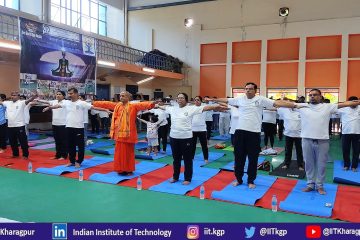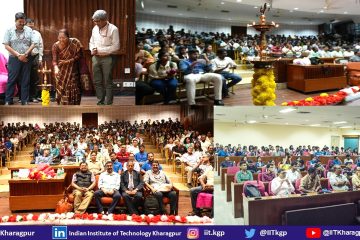 You would have mistaken him for a student. Dark cropped hair, back-pack in place, an incredibly young-looking Debendra Das Sharma approached me for his interview at the Technology Guest House on the evening before the 65th Convocation. He was returning to the campus after more than two decades and was incredibly happy to be back.
You would have mistaken him for a student. Dark cropped hair, back-pack in place, an incredibly young-looking Debendra Das Sharma approached me for his interview at the Technology Guest House on the evening before the 65th Convocation. He was returning to the campus after more than two decades and was incredibly happy to be back.
 As Principal Engineer in Intel Corporation, Sharma has been leading the development of PCI Express since its inception two decades back through six generations of evolution of the technology. He has played a key role in evolving PCI Express as a ubiquitous I/O interconnect in the industry, spanning the entire compute continuum. More recently, he has led the development of Compute Express Link, an interconnect technology to harness the power of the heterogeneous processing elements. He drives the evolution of this technology with a consortium of 75 companies.
As Principal Engineer in Intel Corporation, Sharma has been leading the development of PCI Express since its inception two decades back through six generations of evolution of the technology. He has played a key role in evolving PCI Express as a ubiquitous I/O interconnect in the industry, spanning the entire compute continuum. More recently, he has led the development of Compute Express Link, an interconnect technology to harness the power of the heterogeneous processing elements. He drives the evolution of this technology with a consortium of 75 companies.
Yet he feels “humbled” to be a recipient of the DAA. “Looking at the calibre of the people receiving the award, you always feel, am I good enough?…It is such an illustrious group of people,” he told me that evening, shaking his head, as if still unable to believe his good fortune.
Sharma appeared to be slightly uneasy at not having been an “active alumnus”. “I just got busy”, he said apologetically. His eyes sparkled as we got talking about his time at IIT KGP. He recalled a professor whose homework the entire class had decided to give a miss. “If you don’t do the work, my salary remains the same, but you don’t gain anything,” the professor had said. And those words had profoundly affected Sharma, making him conscious of the value of time and real learning.
 “My foundation got laid here,” Sharma explained. “Most of us came away from home and lived our life in hostels. And that was an invaluable experience for you learnt not only the hard skills but also the soft skills here – how do you interact with people, how do you collaborate, how do you relate to people…all of those at an impressionable age when you are absorbing a lot That sets you up for life.”
“My foundation got laid here,” Sharma explained. “Most of us came away from home and lived our life in hostels. And that was an invaluable experience for you learnt not only the hard skills but also the soft skills here – how do you interact with people, how do you collaborate, how do you relate to people…all of those at an impressionable age when you are absorbing a lot That sets you up for life.”
Across the rooms on the same floor of TGH, G.C. Mitra, among the seniormost awardees, told me something similar. Prof. Sean Mackay, his teacher and a major influence in his life, had told him that IIT stood for something. “The first ‘I’ is for interest in all that you see, the second ‘I’ for integrity in all that you do and the ‘T’ is for truthfulness in all your transactions,” said Mitra, who had interrupted his puja to talk to me. All through his life, Mitra has tried his best to live up to that ideal. He has also tried to live by the advice the IIT Kharagpur Director had given him on the day of graduation in 1958. Try not to follow, instead become a pioneer, he had said.
 Pampering me with a steady supply of tea and biscuits during the conversation, Mitra talked to me about his life and work, with which IIT Kharagpur has remained seamlessly entwined. His idea to become a member of the Institution of Structural Engineers, UK, had been prompted by Prof. Mackay. “I passed the third paper after several attempts, ” Mitra told me candidly. “You know, Indians are good with theory, not practice,” he said, tongue in cheek.
Pampering me with a steady supply of tea and biscuits during the conversation, Mitra talked to me about his life and work, with which IIT Kharagpur has remained seamlessly entwined. His idea to become a member of the Institution of Structural Engineers, UK, had been prompted by Prof. Mackay. “I passed the third paper after several attempts, ” Mitra told me candidly. “You know, Indians are good with theory, not practice,” he said, tongue in cheek.
But what I got to hear from him was entirely a theory of life in practice, a theory he had learnt at IIT Kharagpur. As Engineer-in-Chief in the service of the Government of Odisha, Mitra became a pioneering figure in relief and rehabilitation work as part of the Odisha government, winning the Padma Shri in 2003 in recognition of his services. The cyclone shelters constructed in the state along its coastal belt under his watch from the Prime Minister’s support fund have saved the lives of millions of people in the state, even during the time of recent Cyclone Fani.
 “You know,” he told me, “the backward in our country go back ten steps every time there is a natural disaster. SCs and STs constitute 36 per cent in Odisha. They are regarded as deprived category, but even 50 per cent of those who are not regarded as deprived are extremely poor.”
“You know,” he told me, “the backward in our country go back ten steps every time there is a natural disaster. SCs and STs constitute 36 per cent in Odisha. They are regarded as deprived category, but even 50 per cent of those who are not regarded as deprived are extremely poor.”
A man who has been closely associated with the lives of the downtrodden is also acutely aware of their pride, their self-esteem. For years, despite their suffering, he said, the people of the Ganjam district, one of the most prosperous rice-producing regions of Odisha, had not asked the government for help. But 1990 had been different, he recalled. Even the fool proof traditional method of storing paddy had failed to secure the grain from the ravages of the water.
The impetus led to a series of cyclone, flood or storm surge shelters being built in existing high school and primary schools. “We built around 1255,” Mitra said. But that is not all he built. During his time in the Odisha administration, Mitra facilitated the construction of bridges across Mahanadi that have gone a long way in bringing the north and south Odisha together. Mitra has also been associated with the conservation of the Lord Jagannath Temple at Puri and the Sun Temple at Konark and executed national and international projects.
Despite his busy career, Mitra has taught at IIT Kharagpur on short stints. He also helped the Institute get land for the building of the IIT Kharagpur extension centre at Bhubaneswar, where he was Professor-in-charge and contributed immensely to the development of the centre.
Elated at receiving the DAA, Mitra told me, “I have no regrets at all in my 82 years of life.” His advice to IIT Kharagpur’s students? I asked. “Follow what Prof. Mackay and the Director had to say. I followed them,” he signed off.
Graphics : Suman Sutradhar



